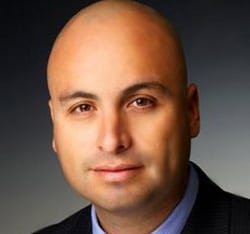
State Auditor Hector Balderas
The New Mexico Finance Authority, which acts as a bank for government agencies, is at risk because it hasn’t been audited for fiscal year 2011. In addition, a former employee is alleged to have fraudulently made claims about the agency’s financial health. The question is, why?
There are more questions than answers right now about why the New Mexico Finance Authority’s controller allegedly created a fraudulent audit of the agency’s finances, but what’s clear is that it’s a big deal.
State Auditor Hector Balderas announced Thursday that his agency had uncovered the fraudulent audit. In a news release, his office announced that a special audit of NMFA’s books would be conducted.
NMFA quickly announced that it had retained a law firm “to conduct a thorough investigation to determine how the misrepresentation occurred and to recommend steps for strengthening financial reporting procedures,” and had hired an accounting firm to complete the agency’s fiscal year 2011 audit.
Balderas also turned the matter over to law enforcement.
“I am moving aggressively to determine the full extent of this fraud perpetrated against New Mexico’s taxpayers,” Balderas said. “I’m extremely concerned that a report was fraudulently created in order to misrepresent the authority’s financial condition to agencies, investors and the public.”
The public confirmation of the situation by the state auditor and NMFA came as KOB-TV’s Gadi Schwartz was preparing an investigative report on the matter. You can watch Schwartz explain why the matter is important here.
In short, Schwartz reported, the situation has the potential to affect the agency’s credit rating and its interest rates when it issues bonds to fund projects. That could cost taxpayers additional money.
In a news release, NMFA’s chief executive officer, Richard E. May, called the situation “deeply concerning,” but said it would “have no effect on NMFA’s ability to meet its financial obligations.”
“NMFA remains financially strong and has ample resources to meet all scheduled bond payments and other expenses,” he said.
Still, “under the circumstances,” the NMFA news release states that the agency has “delayed the planned offering of Series 2012B Senior Lien Public Project Revolving Fund Revenue Bonds until after the audit of its financial results has been completed.”
Agency points finger at former controller
The fraudulent audit means NMFA, which acts as a bank for government agencies in New Mexico and issued bonds that helped fund projects such as Spaceport America and the Rail Runner, hasn’t been audited for fiscal year 2011. That fiscal year covered the final six months of Bill Richardson’s tenure as governor and Susana Martinez’s first six months.
So it’s possible that not even NMFA officials have a full picture of the agency’s current financial standing. In fiscal year 2010, NMFA’s total operating expenses were almost $128 million, and its total liabilities and net assets were more than $1.8 billion.
The fraudulent fiscal year 2011 audit was never submitted to Balderas’ office, which identified NMFA as being at risk for fraud, waste and abuse in May because the agency was so late in filing its required annual audit. That red flag ultimately led to the discovery of the fraudulent audit, which had apparently been released to Wall Street.
NMFA pointed the finger at its former controller. The agency’s news release said the former employee, who left in early June “before the issue was discovered,” had “provided financial statements for use with third parties that he falsely represented as ‘audited’ by NMFA’s outside auditing firm Clifton Gunderson LLP.”
The Maryland firm confirmed to Balderas’ office that the audit the controller was circulating is not its work. The NMFA did not name the controller in question, but NMPolitics.net has learned that his name is Greg Campbell.
In his news release, Balderas didn’t point the finger at any specific current or former NMFA official.
NMFA is familiar with scandal
This isn’t the first time NMFA has been at the center of scandal in recent years. The agency was caught up in the transportation-bond scandal that dogged Richardson’s tenure. Federal investigators were ultimately unsuccessful in efforts to bring a pay-to-play case against Richardson and others in that case, but the U.S. attorney said in 2009 that they should not consider themselves exonerated.
Here’s a reminder of NMFA’s role in that scandal from Bloomberg News:
“David Rubin, president and chief executive officer of Beverly Hills, California-based CDR Financial Products, one of the brokers raided by federal investigators, contributed a combined $100,000 to political action committees formed by New Mexico Governor Bill Richardson in 2003 and 2004. CDR made $951,566 advising the New Mexico Finance Authority on $420 million of interest-rate swaps in 2004.”
Though charges have never been brought against Richardson or others in that case – and he and others have always maintained that they did nothing illegal – recent testimony in a separate case involving CDR implicated Richardson in a pay-to-play scheme involving CDR and the NMFA contract.
The governor essentially controls NMFA. Its 12-member board includes four cabinet secretaries and six others the governor appoints.
At this point officials don’t know why the fraudulent audit was created or circulated on Wall Street and whether it was to cover up a crime. But the fact that the fraudulent audit covered the last six months of Richardson’s tenure – while the former governor and many others close to him prepared to vacate government jobs – is raising some eyebrows.
Another question: How did the fraudulent audit get all the way to Wall Street? Audits are required to be reviewed at an exit conference by multiple NMFA officials and a representative of the auditing firm. Was such an exit conference held?
Balderas hopes to learn the answers to these questions now that a special audit will be conducted.
